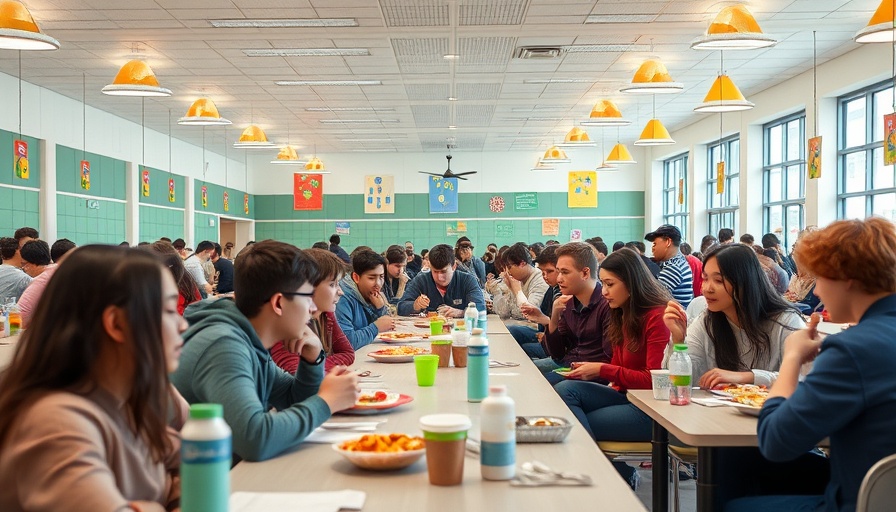
School Dinners: A Path to Healthier Eating Habits
Recent research from the University of Bristol has shed light on an important behavioral shift in the eating habits of picky teenagers. The study indicates that school dinners may play a pivotal role in encouraging these selective eaters to broaden their food preferences, particularly when it comes to fruits and vegetables. This revelation is not just a small observation but offers a glimpse into effective strategies for promoting healthier eating routines among teens.
The Impact of Choice on Eating Behavior
The core of the study reveals that when picky eaters are given the autonomy to choose from a variety of school dinner options, they exhibit less pickiness in their food selections. This study analyzed data from over 5,300 participants in the longitudinal Children of the 90s study, merging childhood dietary habits with current behaviors. Interestingly, children who typically bring packed lunches tend to avoid healthier options, preferring items that are less nutritious. However, the shift to school dinners opened up new possibilities for them, allowing for better dietary variety.
This Could Be a Game Changer for Public Health
Encouraging teens to step outside their comfort zones when it comes to food can have lasting benefits. The findings highlight a shift toward healthier habits not only in individual meals but also in broader dietary patterns. According to Dr. Caroline Taylor, the lead researcher, promoting diverse eating can alleviate some of the common nutritional deficiencies observed in picky eaters. By exposing teens to a wider array of foods in a social setting, schools can contribute to developing lifelong healthy eating habits.
The Nutritional Landscape of Today's Teens
The study's results indicated that, while picky children often consume fewer fruits and vegetables compared to their peers, the introduction of school dinners resulted in a noticeable increase in the intake of these vital food groups. Almost all children, regardless of pickiness, were still not consuming enough vegetables, underscoring the importance of school meal programs in addressing nutritional gaps. Fruits and vegetables are crucial for providing the fiber, vitamins, and minerals necessary for healthy development and to mitigate long-term health risks.
Tips for Parents: Enhancing the School Dinner Experience
As parents, there are several strategies you can implement to foster healthy eating habits for your children, whether or not they opt for school dinners. Encourage family meals that prioritize conversation and engagement, serve as a role model by maintaining your healthy eating habits, and involve your teenagers in meal preparation. These practices not only help to make healthful eating enjoyable but also instill a sense of responsibility and ownership regarding food choices.
Expanding Culinary Choices: What Does the Future Hold?
The implications of this research extend beyond just encouraging children to eat a variety of foods. They reflect a greater understanding of how adolescent eating habits can evolve in settings that promote choice and social interaction. As schools reevaluate their meal programs, there is an opportunity to design menus that align with wellness goals and highlight nutritious options. This effort could significantly improve the overall dietary intake of students and support both physical and mental health.
Common Misconceptions: The Truth About Picky Eating
Many parents view picky eating as merely a phase. However, as this study illustrates, it can extend well beyond toddlerhood into the teenage years. Understanding that picky eating behavior can have rooted social and environmental influences is vital. Parents and educators must adapt their strategies as children grow, ensuring that options remain appealing and varied.
The Path Forward: Collaborative Efforts for Healthier Schools
It’s essential for schools, parents, and communities to work together to enhance the dietary experiences of adolescents. By cultivating an environment that celebrates diversity in food choices through engaging school lunch programs, there’s potential for significant strides in student health. Support initiatives that prioritize fresh produce, provide culinary education, and create interactive lunch experiences to help kids develop a healthy relationship with food.
By fostering an environment where school dinners are embraced and celebrated, we can inspire the next generation to embrace nutritious food and make healthy lifestyle choices long into adulthood. To learn more about how you can implement these changes in your daily routines, consider sharing your experiences and strategies with friends and family.
 Add Element
Add Element  Add Row
Add Row 



 Add Row
Add Row  Add
Add 


Write A Comment